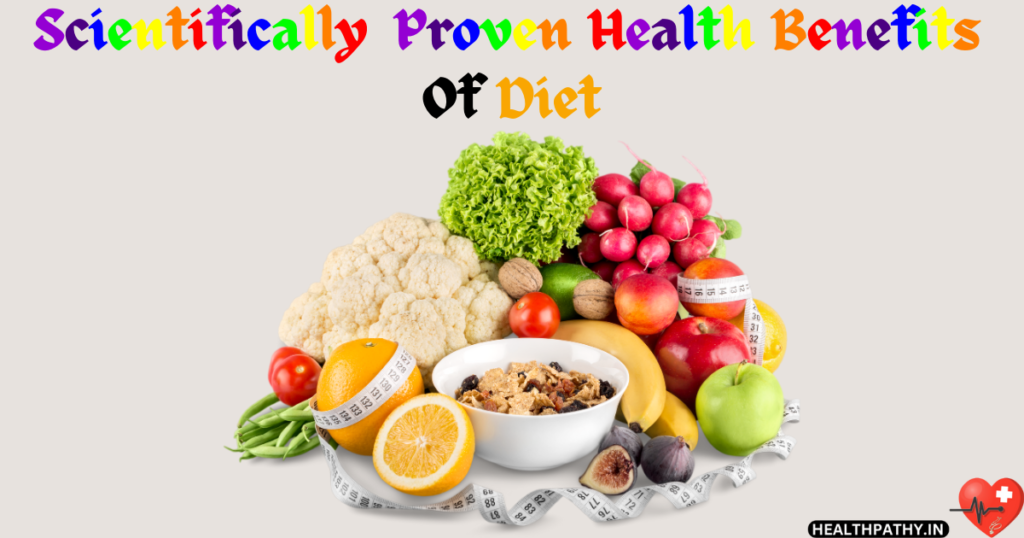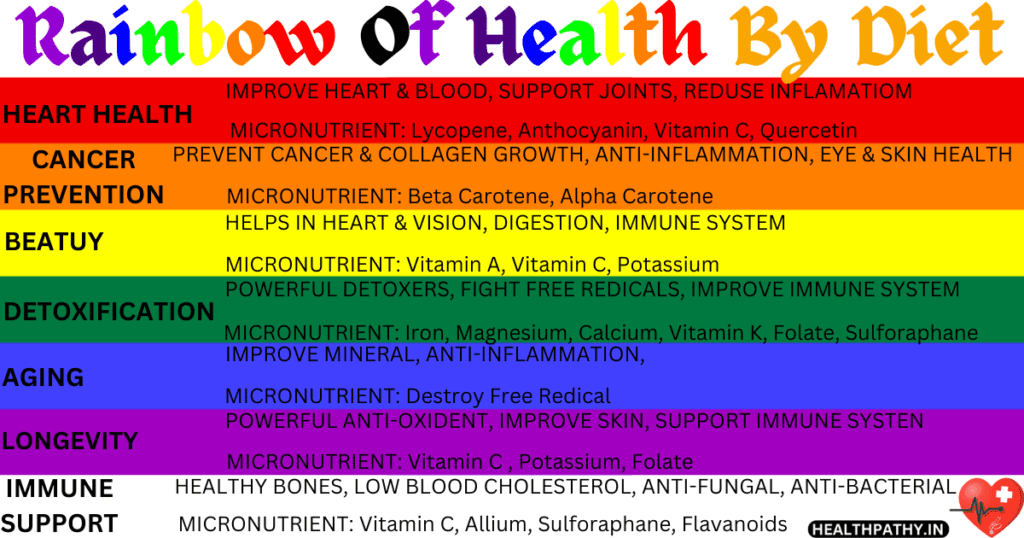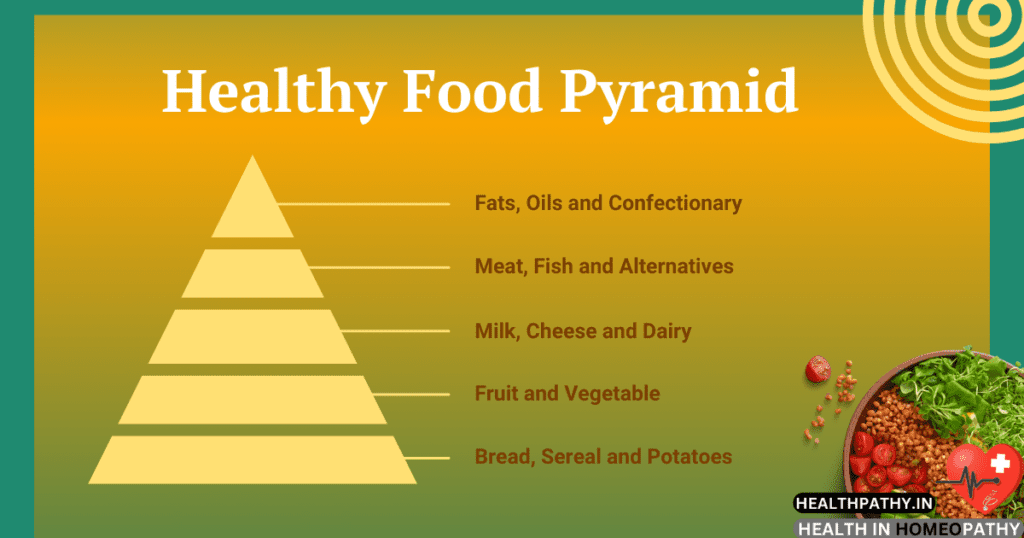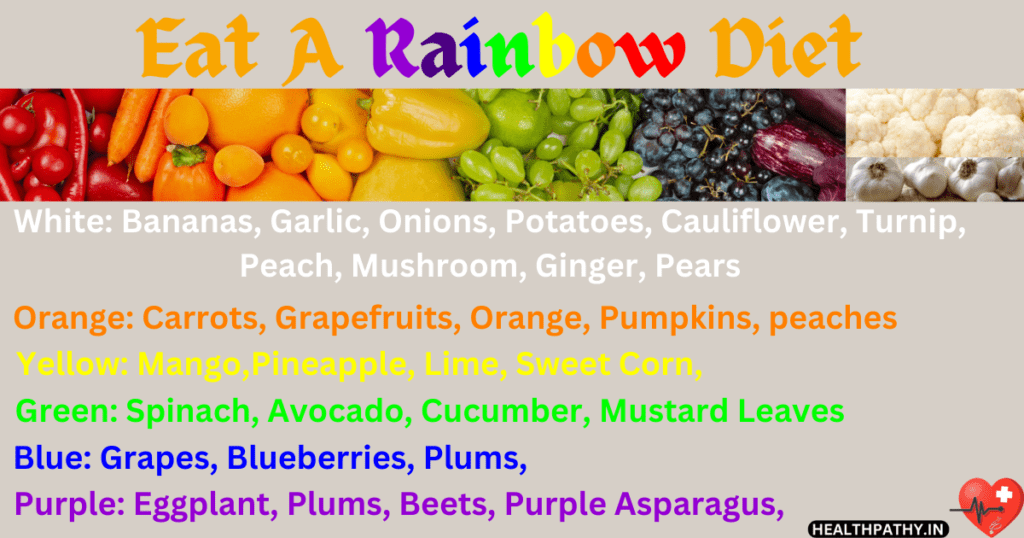Hello, I’m a homeopathic doctor with over 26 years of clinical practice, starting in 1997. My passion is to simplify complex medical concepts so that everyone can understand them. Join me on this educational adventure as I examine the Scientifically Proven Health Benefits of Diet in a way that everyone can understand. Let’s take a trip into the world of holistic health together!
- Scientifically Proven Health Benefits Of Diet
- The Endless Benefits of a Balanced Diet: Nourishing Your Way to Health
- Eating the Rainbow: Unlocking the Nutritional Power of Colorful Foods
- The Vibrant Spectrum of Nutrition: Exploring Alkaline and Acidic Foods for Optimal Health
- Eating Your Way to Health: Tailored Diets for Common Ailments
- 1. Heart-Friendly Diet for Hypertension and Heart Disease
- 2. The DASH Diet for Hypertension
- 3. The Mediterranean Diet for Diabetes Management
- 4. Anti-Inflammatory Diet for Arthritis
- 5. Plant-Based Diets for Digestive Health
- 6. Gluten-Free Diet for Celiac Disease
- 7. Low-FODMAP Diet for Irritable Bowel Syndrome (IBS)
- 8. The Ketogenic Diet for Epilepsy
- 9. The MIND Diet for Cognitive Health
- Must Read:
- Must Watch:


The Endless Benefits of a Balanced Diet: Nourishing Your Way to Health
Maintaining a healthy diet program is important for overall well-being. It affects various factors of fitness, including bodily, mental, and emotional. In this article, we are able to explore the great benefits of a balanced and nutritious diet plan.
A balanced diet is frequently seen as the cornerstone of precise fitness. The meals we eat significantly affect our well-being, from our energy level to our longevity. This article delves into the great realm of diet plans and their profound impact on fitness. We will uncover the various factors of health that diet impacts and offer sensible recommendations on how to keep a balanced and nutritious food plan for ideal fitness.
The Physical Benefits of a Balanced Diet
- Weight Management: A balanced eating regimen is critical for coping with body weight. We discover how the proper food alternatives can help with weight reduction or preservation.
- Disease Prevention: Diet plays a critical role in preventing diverse chronic illnesses, which include coronary heart sickness, diabetes, and certain kinds of cancer.
- Gut Health: A healthy weight-reduction plan is intently linked to intestine fitness. We explore how a diet plan can aid a thriving intestine microbiome and promote digestion.
- Bone Health: Nutrients like calcium and vitamin D are critical for retaining sturdy bones. A balanced eating regimen supports bone health and prevents conditions like osteoporosis.
- Energy and Vitality: We speak about the function of macronutrients in supplying energy for day-by-day activities and how diet plans influence overall energy.
- Skin Health: Diet influences the fitness and look of the skin. We delve into how precise nutrients can promote a sparkling complexion.
The Mental and Emotional Benefits of a Balanced Diet
- Brain Health: The mind relies on the right nutrition to function optimally. We explore the impact of food plans on cognitive characteristics, reminiscence, and mood.
- Stress Management: Diet can have an impact on our response to pressure. We speak foods that help lessen stress and tension.
- Mental Health: Diet performs an extensive function in mental health conditions like depression and anxiety. We discover the relationship between food regimen and emotional well-being.
- Sleep Quality: The meals we devour can affect the quality of our sleep. We provide dietary pointers for a great night time’s rest.
Diet and Longevity
- Aging Gracefully: We explore how a balanced weight loss plan can make contributions to getting older gracefully and retaining bodily and mental fitness as we grow older.
- Longevity Secrets: What we consume can impact our lifespan. We talk about dietary patterns seen in regions with excessive lifestyle expectations.
Practical Tips for a Balanced Diet
- Nutrient-Dense Foods: We outline the significance of selecting nutrient-dense foods for a balanced eating regimen.
- Portion Control: Portion sizes matter. We provide suggestions on how to manage portions efficaciously.
- Meal Planning: Planning food can assist in making a balanced weight-reduction plan. We provide guidance on meal prepping and planning.
- Dietary Restrictions: For people with nutritional regulations, we provide recommendations on keeping a balanced weight loss plan.


Eating the Rainbow: Unlocking the Nutritional Power of Colorful Foods
Our regular food picks no longer only fulfill our taste buds but additionally provide a rainbow of essential vitamins. This article is a colorful adventure through the sector of end results and veggies, exploring the significance of their colorations. You’ll find out how each shade represents a completely unique set of vitamins and health benefits. Get equipped to embrace a colorful weight-reduction plan that nourishes your body from the inside out.
Red Foods
1. Tomatoes: Learn about the antioxidant lycopene, which gives tomatoes their colorful red coloration and helps heart health.
2. Red Peppers: These fiery red vegetables are rich in vitamin C, promoting a robust immune system and healthy skin.
Orange and Yellow Foods
1. Carrots: Understand how beta-carotene in carrots is essential for vision and immunity.
2. Oranges: Discover the power of vitamin C in oranges, contributing to collagen formation and wound recuperation.
Green Foods
1. Spinach: Dive into the arena of iron-rich spinach and its function in power production and healthy blood.
2. Broccoli: Explore the cancer-fighting compounds located in this inexperienced cruciferous veggie.
Blue and Purple Foods
1. Blueberries: Uncover the antioxidants in blueberries that assist brain fitness and combat oxidative stress.
2. Eggplant: Learn about the potential heart advantages of the purple-hued eggplant.
White Foods
1. Cauliflower: Explore how this cruciferous vegetable aids digestion and boosts your consumption of essential minerals.
2. Garlic: Discover the immune-boosting properties of garlic and its role in reducing the chance of persistent diseases.
Black Foods
1. Black Beans: Understand the fiber-protein-rich traits of black beans, ideal for coronary heart and digestive health.
2. Blackberries: Delve into the fitness advantages of blackberries and their antioxidant content.
Putting It All Together
Explore how incorporating a selection of colorful ingredients into your everyday diet can provide a huge spectrum of essential nutrients, making sure you enjoy a colorful and wholesome life.
Tips for a Colorful Diet
1 Make a conscious effort to include a variety of colorful foods in every meal.
2 Experiment with distinctive recipes to add more colorful fruits and vegetables to your eating regimen.
3 Visit local farmers’ markets to explore seasonal and colorful produce options.
Conclusion
Eating the rainbow isn’t always only a ceremonial dinner for the eyes; it’s a feast on your body’s fitness. The colors in our meals constitute nature’s way of presenting us with the vitamins we want for well-being. So, make it a point to embody the entire spectrum of colors on your plate, and you may be savoring the delicious flavor of proper fitness.


The Vibrant Spectrum of Nutrition: Exploring Alkaline and Acidic Foods for Optimal Health
Our dietary alternatives have a profound effect on our health, and one essential component to take into account is the pH balance within our bodies. This article takes an in-depth study of alkaline and acidic foods, providing a complete understanding of their effects on our well-being and offering practical insights into making informed dietary choices.
The ingredients we consume play a considerable role in maintaining the delicate stability of our body’s pH ranges. In this newsletter, we can delve into the ideas of alkaline and acidic foods, explaining what they are and how they affect our health. By the end, you will have a better understanding of how to make informed dietary choices that can promote standard well-being.
Alkaline Foods: Nurturing the Body’s Balance
1. Leafy Greens: A Verdant Elixir for Alkalinity
Delve into the sector of leafy vegetables like spinach, kale, and Swiss chard, coming across their excessive mineral content and material function in preserving an alkaline kingdom in the body.
2. Cucumbers: The Crisp and Hydrating Alkaline Heroes
Explore the refreshing and hydrating properties of cucumbers and learn how they no longer assist with hydration but additionally make contributions to alkalinity in the body.
3. Cruciferous Vegetables: Power-Packed Alkaline Allies
Uncover the exceptional fitness advantages of cruciferous veggies, including broccoli, cauliflower, and Brussels sprouts, recognized for their alkalizing impact and cancer-preventing compounds.
4. Citrus Fruits: Acidity with an Alkaline Twist
Gain deeper know-how of why citrus fruits like lemons and oranges, despite their acidic flavor, have an alkalizing impact inside the frame, promoting typical fitness.
Acidic Foods: The Culprits and Exceptions
1. Vinegar: The Acidic Culprit with Health Benefits
Learn approximately the capacity downsides of acidic ingredients like vinegar, while additionally exploring how a slight intake can offer positive fitness advantages.
2. Dairy and Animal Protein: Acidic Yet Nutrient-Rich
Delve into the acidic nature of dairy and animal protein and apprehend how they can still be part of a balanced food plan, offering important nutrients.
The Balancing Act: pH and Your Health
Understand the significance of pH balance in maintaining average fitness. Excessive acidity can lead to health issues like acid reflux and osteoporosis, while an alkaline environment can offer several benefits, including decreased infection and improved immune function.
Practical Tips for a Balanced Diet
Incorporate more leafy vegetables and non-starchy veggies into your everyday meals.
Consider the alkaline and acidic outcomes of ingredients while planning your dietary selections to promote stability.
Conclusion
The difficulty courting between alkaline and acidic meals is an often underestimated issue of our fitness. By being conscious of the effect one-of-a-kind meals have on our body’s pH ranges, we can make more knowledgeable selections that extensively contribute to our basic well-being. Striking the proper balance between alkaline and acidic ingredients is the key to a more fit and happier lifestyle. Remember, it is no longer about casting off one class but monetizing each for gold-standard fitness.


Eating Your Way to Health: Tailored Diets for Common Ailments
Food isn’t only a supply of sustenance but also an effective tool for preserving fitness and preventing common ailments. This article delves into the sector of nutritional therapy, supplying insights into how precise diets can help manipulate and alleviate the signs of commonplace fitness problems.
1. Heart-Friendly Diet for Hypertension and Heart Disease
Learn how an eating regimen rich in veggies, whole grains, and lean proteins can assist in managing excessive blood pressure and decrease the risk of heart disease.
A coronary heart-friendly diet plan includes lots of:
Fresh fruits (e.g. apples, berries, citrus), Vegetables (e.g. spinach, carrots, broccoli), Whole grains (e.g. oats, quinoa), Lean proteins (e.g. fowl, fish)
Example: Grilled salmon with a facet of quinoa and steamed broccoli.
2. The DASH Diet for Hypertension
The DASH diet, short for Dietary Approaches to Stop Hypertension, is a nutritional plan designed to prevent and manage excessive blood pressure (hypertension). It emphasizes a balanced and coronary-heart-wolesome method of consumption. The DASH food plan isn’t the best effective for lowering blood pressure, however additionally promotes universal health. Here’s some evidence of the DASH eating regimen:
1. Lower Sodium Intake:
A hallmark of the DASH diet is reducing sodium (salt) intake. High sodium consumption is a leading contributor to high blood stress. The eating regimen recommends limiting daily sodium consumption to about 2,300 milligrams (mg), or ideally, 1,500 mg for even better blood pressure control.
2. Balanced Macronutrients:
The DASH diet program promotes a balanced consumption of macronutrients, with a focal point on:
Fruits and Vegetables: Aim to eat 4-5 servings of fruits and 4-5 servings of green vegetables each day. These are rich in crucial nutrients, minerals, fiber, and antioxidants.
Whole Grains: Choose entire grains like brown rice, whole wheat, and oats over refined grains. They are an awesome supply of fiber and nutrients.
Lean Protein: Opt for lean protein resources, which include poultry, fish, and plant-primarily based proteins like beans, lentils, and tofu.
Low-Fat Dairy: Include low-fat or fat-loose dairy products like milk, yogurt, and cheese.
3. Healthy Fats:
The DASH food plan encourages the intake of coronary heart-healthy fats, especially the ones excessive in monounsaturated and polyunsaturated fats. These fats can be found in olive oil, avocados, and nuts.
4. Limit Saturated and Trans Fats:
To shield heart health, the DASH weight loss plan advises minimizing saturated fats, generally located in red meat, pork, full-fat dairy products, and tropical oils, as well as eliminating trans fats from partly hydrogenated oils and lots of processed foods.
5. Reducing Added Sugars:
The DASH food plan suggests proscribing the consumption of added sugars and candies to promote better normal fitness.
6. Portion Control:
Managing portion sizes is prime to weight management and average fitness. The DASH food plan emphasizes element attention to help hold a healthy weight.
7. Balanced Nutrient Profile:
The DASH diet plan’s recognition of a ramification of nutrient-dense meals affords crucial nutrients, minerals, and antioxidants that support common health.
8. Moderate Alcohol:
For those who pick out to devour alcohol, the DASH diet suggests moderation. This normally method up to 1 drink (30 ml ) in line with the day for women and up to 2 drinks in line with the day for men.
9. Meal Planning:
The DASH food regimen encourages meal-making plans and education at home to have extra control over meal picks and portion sizes.
The DASH diet program isn’t always the simplest effective for managing blood pressure but additionally for decreasing the threat of heart sickness, stroke, and other chronic situations. It promotes a balanced and sundry consuming plan that includes an extensive variety of nutrient-wealthy foods. It’s important to seek advice from a healthcare expert or dietitian earlier than starting any new weight-reduction plan, particularly when you have particular health concerns.
The DASH food regimen encourages: Sodium reduction, Increased consumption of potassium, calcium, and magnesium
Example: A DASH-friendly meal would possibly encompass a spinach and chickpea salad with a sprinkle of feta cheese.
3. The Mediterranean Diet for Diabetes Management
Delve into the Mediterranean diet plan, celebrated for its blessings in handling diabetes and preserving normal health via the consumption of olive oil, complete grains, and sparkling produce.
Mediterranean food plan emphasizes: Olive oil, Whole grains, Fresh culmination, and veggies
Example: A classic Mediterranean dish is grilled poultry with a Greek salad, topped with olive oil and balsamic vinegar.
4. Anti-Inflammatory Diet for Arthritis
Discover how meals like fatty fish, berries, and green tea can help lessen inflammation and alleviate the symptoms of arthritis.
Anti-inflammatory ingredients encompass: Fatty fish (e.g., salmon), Berries, Green tea
Example: A meal rich in anti-inflammatory elements can be a salmon fillet with an aspect of blueberry and spinach salad.
5. Plant-Based Diets for Digestive Health
Explore plant-primarily based diets like vegetarianism and veganism, regarded for his or her digestive advantages and their capacity to alleviate situations like irritable bowel syndrome (IBS).
Plant-based diets center on Legumes (e.g. lentils), Fiber-rich foods (e.g. beans), Fresh greens (e.g. leafy veggies)
Example: A vegetarian dinner would possibly function as a lentil stew with plenty of leafy veggies.
6. Gluten-Free Diet for Celiac Disease
Understand the significance of a gluten-free diet program for people with celiac disease and find out about appropriate options.
A gluten-free diet program avoids foods like Wheat, Barley, Rye
Example: A gluten-free breakfast will be a bowl of oatmeal with sparkling berries.
7. Low-FODMAP Diet for Irritable Bowel Syndrome (IBS)
The low FODMAP food plan is a nutritional method designed to assist control of symptoms of irritable bowel syndrome (IBS) and other gastrointestinal disorders. FODMAPs are a group of fermentable carbohydrates that may cause digestive discomfort in a few people. The term “FODMAP” stands for Fermentable Oligosaccharides, Disaccharides, Monosaccharides, and Polyols. Here’s a proof of the low FODMAP eating regimen:
1. FODMAPs Explained:
FODMAPs are short-chain carbohydrates that can be poorly absorbed within the small intestine. When they bypass the large gut, they can be fermented by intestine bacteria, leading to signs like gas, bloating, stomach pain, and diarrhea in sensitive people.
2. Dietary Restriction:
The low FODMAP diet plan entails limiting excessive FODMAP meals from your diet plan. These include various end results, vegetables, grains, legumes, dairy products, and sweeteners.
3. Three Phases:
The low FODMAP diet plan is generally divided into three phases:
A. Elimination Phase: During this segment, you remove high-FODMAP ingredients from your food plan for several weeks (commonly 2–6 weeks) to permit your gut to settle and symptoms to improve.
B. Reintroduction Phase: After the removal phase, you systematically reintroduce specific FODMAPs to become aware of which of them cause your signs and symptoms and to what quantity.
C. Personalization Phase: In this phase, you customize your diet plan primarily based on your tolerance level for specific FODMAPs. You can preserve to experience low-FODMAP meals and consume better FODMAP ingredients in moderation.
4. High-FODMAP Foods:
High-FODMAP meals to keep away from throughout the elimination phase might also include:
Oligosaccharides: Found in meals like wheat, rye, onions, garlic, and legumes.
Disaccharides: These are the main ingredients of lactose, along with milk, yogurt, and soft cheese.
Monosaccharides: Foods with excess fructose, like apples, pears, and honey.
Polyols: Found in some fruits, veggies, and sugar alcohols like sorbitol and mannitol.
5. Low-FODMAP Foods:
Low-FODMAP ingredients that can be covered in your food plan encompass:
Proteins: Most meats, fish, poultry, and tofu.
Grains: Rice, quinoa, and gluten-free oats.
Certain Vegetables: Carrots, zucchini, spinach, and others with lower FODMAP content material.
Fruits: Small quantities of berries, oranges, and grapes.
Dairy Alternatives: Lactose-unfastened or plant-based milk and cheeses.
6. Individual Tolerance:
The goal of the low FODMAP diet plan isn’t to dispose of FODMAPs completely but to discover your non-public tolerance degrees for different foods. This lets you enjoy a numerous and nicely balanced diet plan even as you handle digestive symptoms.
The low FODMAP diet is taken into consideration as an effective approach for individuals with IBS and other gastrointestinal problems. However, it must be observed under the supervision of a healthcare expert to make certain nutrients and to tailor the food regimen to a man or woman’s needs.
Low-FODMAP meals encompass: Bananas, Carrots, Rice
Example: A low-FODMAP lunch will be a rice bowl with grilled poultry and cooked carrots.
7. Consulting a Dietitian:
The low FODMAP eating regimen is complicated and ought to be observed with guidance from a registered dietitian or healthcare professional. They permit you to create a customized plan, make sure you get proper nutrition, and manual you through the reintroduction section.
8. The Ketogenic Diet for Epilepsy
Gain insights into the ketogenic food plan, recognized for its effectiveness in dealing with epilepsy, in particular in drug-resistant cases.
The ketogenic diet plan consists of High-fat ingredients (e.g. avocados, nuts), Adequate protein, Minimal carbohydrates
Example: A ketogenic meal might be an avocado and nut salad with an aspect of grilled bird.
9. The MIND Diet for Cognitive Health
The MIND food plan, brief for the “Mediterranean-DASH Diet Intervention for Neurodegenerative Delay,” is a nutritional plan advanced to promote brain health and decrease the chance of neurodegenerative sicknesses, particularly Alzheimer’s sickness. It combines elements of the Mediterranean and DASH diets, each of which might be regarded for their high-quality results on coronary heart and brain health.
Here’s an in-depth rationalization of the MIND food plan:
1. Emphasis on Whole Foods:
The MIND diet encourages the consumption of entire, unprocessed meals. It promotes fruits, veggies, whole grains, lean proteins, and healthy fat.
2. Leafy Greens:
Leafy vegetables, mainly kale, spinach, and collard veggies, are essential components of the MIND diet. They are rich in nutrients and antioxidants that aid brain fitness.
3. Berries:
Berries, along with blueberries and strawberries, are taken into consideration as “brain berries.” They are excessive in antioxidants, especially flavonoids, that have been connected to progressed cognitive function.
4. Nuts:
Nuts, especially walnuts, are good sources of healthful fat, omega-3 fatty acids, and antioxidants. These vitamins are recognized to benefit brain health.
5. Beans:
Beans and legumes are rich in fiber and protein. They provide a regular strength supply and aid average health, which includes brain characteristics.
6. Whole Grains:
The weight loss program favors complete grains like oatmeal, quinoa, and brown rice. These grains are rich in fiber and vitamins that contribute to brain fitness.
7. Olive Oil:
Olive oil, especially virgin olive oil, is the number one supply of healthy fats in the MIND weight loss plan. It carries monounsaturated fat and antioxidants which might be beneficial for the brain.
8. Fish:
Fatty fish like salmon and trout provide omega-3 fatty acids, which can be essential for mental functions. They are recommended for brain health and lowering the threat of cognitive decline.
9. Poultry:
The MIND diet permits for slight consumption of fowl, particularly chook and turkey, which are assets of lean protein.
10. Wine (carefully):
The food plan permits the moderate consumption of red wine. Some research suggests that slight alcohol consumption, in particular red wine, can also have defensive results in the mind.
11. Limit Red Meat and Butter:
The food plan advises reducing the intake of pork and restricting the usage of butter and margarine.
12. Sweets and Pastries in Moderation:
Sweets and pastries must be eaten up sparingly, as high sugar intake has been associated with a higher risk of cognitive decline.
13. Brain-Boosting Foods:
The MIND food plan promotes meals like berries, nuts, and leafy veggies, that have been connected to improved cognitive characteristics and a discounted hazard of neurodegenerative illnesses.
14. Emphasis on Meal Planning:
The MIND diet plan encourages dependent meal planning to include these mind-wolesome meals into daily meals.
15. A Focus on Portions:
Paying attention to portion sizes allows manage caloric consumption and preserve a healthy weight, which is important for brain health.
The MIND eating regimen is understood for its ability to lessen the danger of Alzheimer’s disease when observed constantly. It’s a bendy and balanced eating plan that not simplest helps mind health but additionally blessings overall well-being. It’s vital to talk with a healthcare expert or dietitian before making significant dietary modifications, in particular, if you have particular fitness concerns.
The MIND diet plan recommends: Leafy vegetables (e.g., kale), Berries, Olive oil
Example: A MIND food regimen dinner will be a kale and blueberry salad drizzled with olive oil.
Conclusion
In this complete exploration of the benefits of a balanced diet plan, we’ve got Scientifically Proven Health Benefits Of Diet and uncovered the many ways in which what we devour influences our health. From bodily well-being to mental and emotional health, a balanced diet is the muse of a vibrant and satisfying life. By making knowledgeable picks approximately what we consume, we can harness the strength of nutrients to nourish our manner of health and power.
The announcement “you’re what you devour” rings true in relation to dealing with and stopping not unusual illnesses. Tailoring your diet plan to particular fitness worries may be a powerful way to enhance your well-being. By knowing the link between nutrients and fitness, you could take proactive steps to mitigate fitness issues and experience a life of energy and wellness. Remember to consult with a healthcare professional or dietitian before making substantial nutritional modifications, mainly if you have underlying fitness conditions.
Must Read:
Scientifically Proven Health Benefits Of Family
Scientifically Proven Health Benefits Of Yoga
Must Watch:
Homeopathy: Placebo or Real Medicine? | Homeopathy Is Not A Placebo | Is Homeopathy A Scam?
Friday 04 April 2025 5:34:52:PM
- Acromegaly Cures With Scientifically Proven Homeopathy - 8 February 2024
- Acidity Cures With Scientifically Proven Homeopathy - 1 February 2024
- Appendicitis Cures With Scientifically Proven Homeopathy - 27 January 2024


